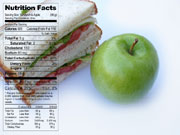Glycemic Load vs. Glycemic Index for Antiaging Nutrition
Glycemic load is a newer and more accurate way of measuring the effect of a meal on your blood sugar level. This new load index uses the carbohydrate count of your foods to determine how glycemic the meal really is.
The Glycemic Index Revisited
When the glycemic index was new, it really was a novel way of going about controlling blood sugar level. However times have changed, and there is a new game in town! The glycemic index is still valuable, but now there is a better way.
Whereas the glycemic index tells you how fast 50 grams of a particular food will raise your blood sugar, it does not account for the portion size that you were eating. Thus it does not give you a true picture of how that food will affect your blood sugar level.

Knowing the carbohydrate count of the meal is essential because the glycemic index can be misleading if you don’t factor in the total amount of carbs (portion size) you are eating. You now have a more accurate standard to go by.
Its important to factor in the nutritional value of the food, vitamins, minerals, fiber, phytonutrients, ect. when determining whether it should be included in your diet.
Some foods that are higher on the glycemic index are actually much more nutritious than other foods that are lower on the index.
Use common sense and remember that foods in their raw and unrefined state are generally better for you than processed foods no matter what their glycemic index is.
How To Measure the Glycemic Load
The load is measured by taking the glycemic index of a particular food, multiplying that by the number of carbohydrate grams the food contains, and then dividing by 100.
The glycemic index is a measure of how fast 50 grams of a particular food will raise your blood sugar. Since you don’t necessarily eat 50 grams of a particular food, you need to know how many grams are in the portion that you ARE eating.
Lets use carrots for an example. Carrots have about 3 grams of carbs each on average. 50 grams of raw carrots have a glycemic index of 47. Say you actually ate 5 carrots which totals out to 15 grams. This is the carbohydrate count.
The formula: 47(glycemic index of carrots) x 15(grams of carrots) = 705
Then divide 705 by 100 = 7.05
7.05 is the glycemic load of the five carrots you just ate. This is low on the index, and in reality you would most likely not consume 5 carrots at one sitting so the load would even be lower!

The index values fall into three categories:
- Low: 1-10
- Medium: 10-20
- High: 20+
So your carrots which have a moderately high “glycemic index” actually have a low “ load index” when you eat them in a normal portion, because the actual carbohydrate count is relatively low.
Glycemic Load and Antiaging
Since insulin levels are a key factor in aging, the most important thing you can do is to eat in a way that keeps your blood sugar level as low as possible. Using the load index as a guide is a more accurate way of doing this.
It is more reflective of the effect your meals will have on your blood sugar and insulin levels, because it takes into account the portion sizes that you are eating, rather than the 50-gram standard that the glycemic index is based on.
Blood sugar control is one of the keys to health and longevity, and glycemic load based on carbohydrate count is the best way to calculate the impact of your diet on blood sugar level, and an important tool you can use to ensure good health and long life.
Return to Longevity and Antiaging Secrets Home Page
New! Comments
Care to comment? Feel free to leave your comments below!